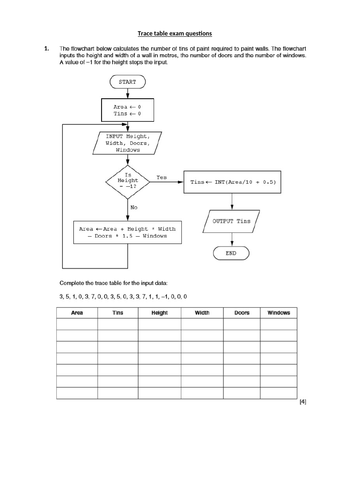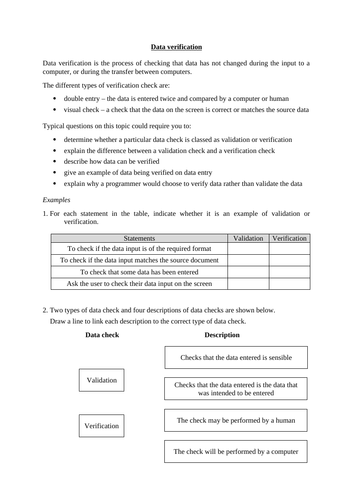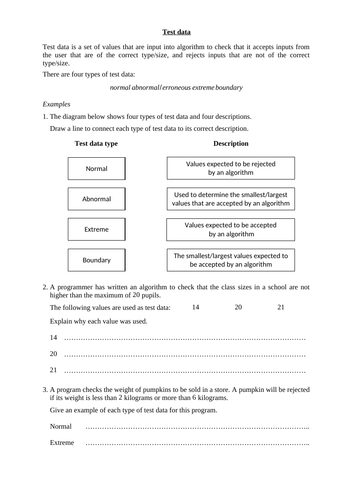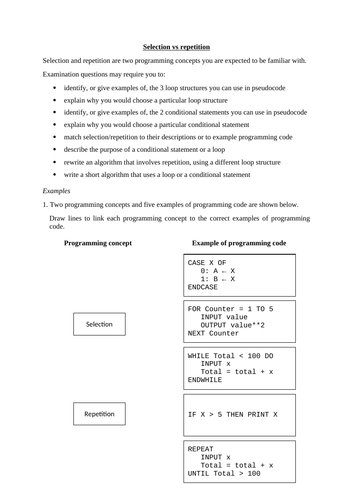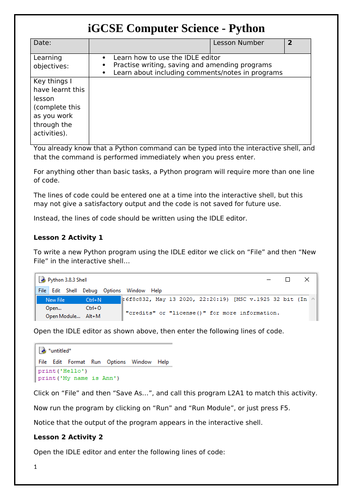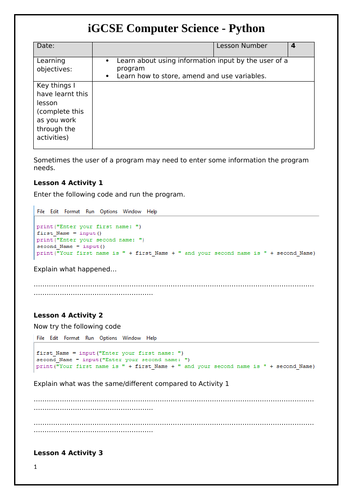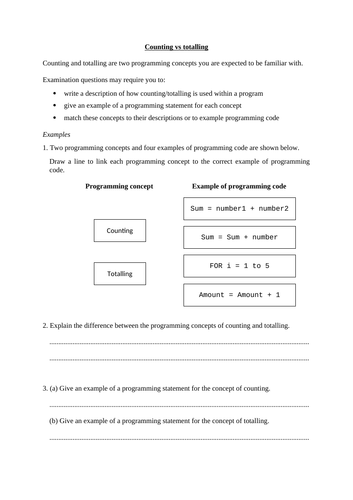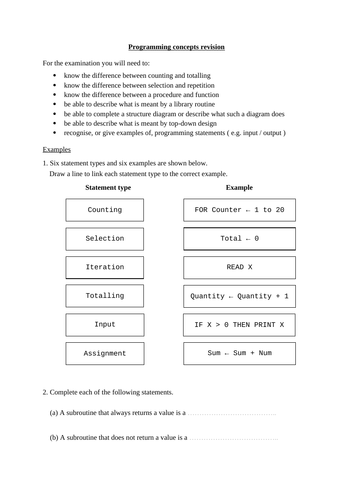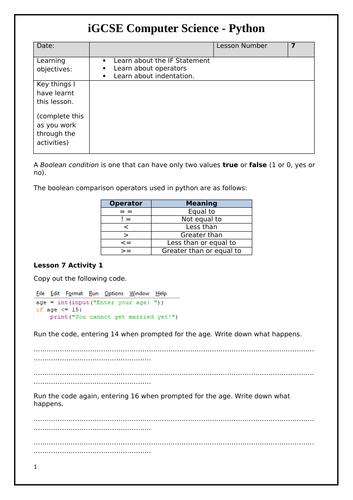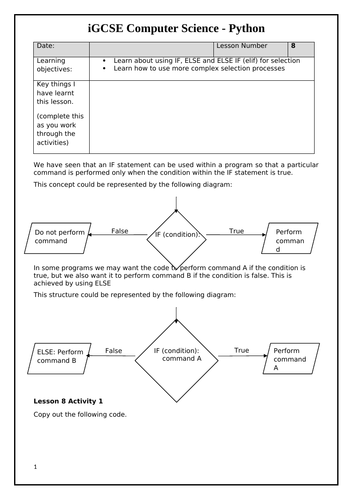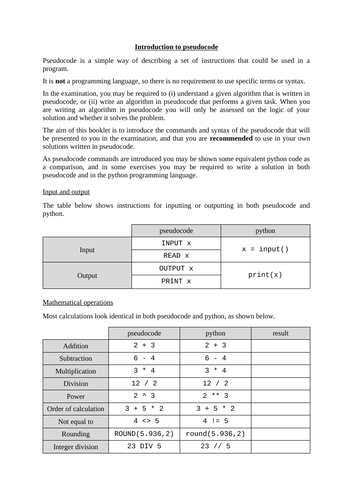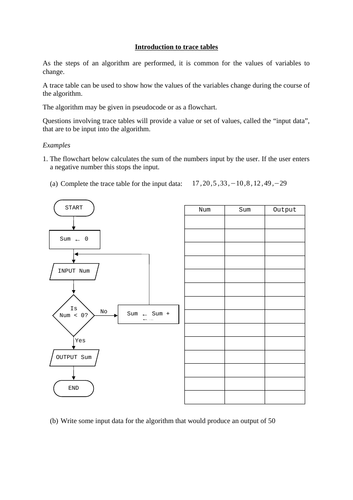31Uploads
10k+Views
6k+Downloads
All resources

Trace table exam questions (iGCSE Computer Science)
This resource is based on a selection of 17 questions on trace tables taken from past papers.
The first document contains the exam questions, which can be printed for your pupils.
The second document is a spreadsheet designed to help the students get the trace tables correct before they fill in the printed document - as they fill in each cell within a trace table, it will stay black if it is correct, but turn red if it is wrong. This means they will be aware of any error as soon as they make it, rather than working through the whole table and only realising at the end that they need to make corrections.
The third document is the answers (mark schemes) to the questions.

Data validation (iGCSE Computer Science)
This short resource introduces the different types of validation checks a computer may perform.
There are some example questions to work through with your group, and answers are provided.

Data verification (iGCSE Computer Science)
This short resource introduces the different types of verification checks a computer or person may perform.
There are some example questions to work through with your group, and answers are provided.

Program development life cycle (0984 iGCSE Computer Science)
This short resource can be used to teach students about the life cycle of program development.
It shows the 4 stages of the cycle and has some brief notes on each stage. There is then a one-page exercise for students to attempt (answers included).

Test data (iGCSE Computer Science)
This short resource introduces the different types of test data that may be used when checking an algorithm performs correctly.
There are some example questions to work through with your group, and answers are provided.

Using variables in Python programs
This short booklet introduces how variables are defined and used within Python.
The booklet is designed for pupils to work through independently, so they can progress and learn at their own pace and you just support and guide as necessary.
Solutions are included in a separate booklet.

Selection vs repetition (iGCSE Computer Science)
This resource focuses on the two programming concepts of selection and repetition.
It begins with the expected knowledge/skills for this topic, followed by a few examples to work through as a group. Finally, there is an exercise of 12 exam questions taken from past papers.
Solutions (mark schemes) are included for the exercise, and notes/solutions to the introduction and examples are included in the teacher’s version,

Writing and saving Python programs using the IDLE editor
This short booklet shows pupils how they use the IDLE editor to write and save programs. It also shows how comments can be added within programs.
The booklet is designed for pupils to work through independently, so they can progress and learn at their own pace and you just support and guide as necessary.
Solutions are included in a separate booklet.

Using the input command in Python
This short worksheet introduces how the input command allows the user of a Python program to enter strings, and how to store the input.
The booklet is designed for pupils to work through independently, so they can progress and learn at their own pace and you just support and guide as necessary.
Solutions are included on a separate sheet.

Introduction to Python - printing
This short booklet can be used as an introduction to the Python programming language. After a short introduction activity, pupils practise typing commands into the interactive shell to learn how the print command works.
The booklet is designed for pupils to work through independently, so they can progress and learn at their own pace and you just support and guide as necessary.
Solutions to all activities are included in a separate booklet.

Counting vs totalling (iGCSE Computer Science)
This resource focuses on the programming concepts of counting and totalling.
It starts with 3 introductory examples to work through as a group, followed by an exercise for pupils to attempt themselves.
Answers to the exercise are included.

Programming concepts revision (iGCSE Computer Science)
This resource can be used to revise the topic of programming concepts. It briefly covers each of: counting, totalling, selection, repetition, procedures, functions, library routines, structure diagrams, and top-down design.
There are 7 example questions to work through, either as a class or for the pupils to attempt on their own.
Solutions are provided.

Data structures (iGCSE Computer Science)
This resource focuses on the different data structures pupils are expected to be familiar with for the iGCSE Computer Science course.
It begins with some examples to work through as a group, followed by an exercise with 12 questions for pupils to complete themselves.
Answers to the exercise are included.

Calculations in Python
This short worksheet introduces how different types of calculations are performed in Python, and how numbers can be input by a user and stored or used within a program. The worksheet includes a number of short programming tasks at the end.
The booklet is designed for pupils to work through independently, so they can progress and learn at their own pace and you just support and guide as necessary.
Solutions are included in a separate booklet.

Using AND, OR and NOT in Python
This booklet introduces how the commands AND, OR and NOT can we used within conditional statement in Python. There are several programming activities at the end of the booklet for pupils to attempt.
The booklet is designed for pupils to work through independently, so they can progress and learn at their own pace and you just support and guide as necessary.
Solutions are included in a separate booklet.

IF statements in Python
This short booklet introduces how the IF statement is used within Python programs, and includes several programming tasks.
The booklet is designed for pupils to work through independently, so they can progress and learn at their own pace and you just support and guide as necessary.
Solutions are included in a separate booklet.

Data types, comparisons and substrings in Python
This booklet covers the names of data types in Python and how to work with different types of data. It includes use of comparison operators, rounding values, and finding substrings.
The booklet is designed for pupils to work through independently, so they can progress and learn at their own pace and you just support and guide as necessary.
Solutions are included in a separate booklet

Using ELSE and ELIF in Python
This 7-page booklet introduces how ELSE and ELIF are used within Python programs, and includes lots of programming activities for pupils to practise writing algorithms using these commands.
The booklet is designed for pupils to work through independently, so they can progress and learn at their own pace and you just support and guide as necessary.
Solutions are included in a separate booklet.

Introduction to pseudocode (iGCSE Computer Science)
This 13 page resource is designed to introduce students to the basics of pseudocode, as required for the new iGCSE Computer Science specification (from 2023).
Section A covers input/output, mathematical operations, comments, declaring variables/constants, and assigning values. Each command is introduced with some examples and, where appropriate, is compared with equivalent commands in Python. Exercise A has 13 questions for students to practise working with these commands.
Section B covers strings and substrings, procedures and functions, declaring an array/list, and working with arrays/lists. Each command is introduced with some examples and, where appropriate, is compared with equivalent commands in Python. Exercise B has 15 questions for students to practise working with these commands.
Answers to the exercises are included, and answers to any examples are included in the teacher’s version of the resource.

Trace tables - iGCSE Computer Science
This 14-page resource introduces how trace tables can be used to show how the values of variables change during the course of an algorithm.
It begins with 3 examples to work through as a group, followed by an exercise with 11 questions for pupils to attempt themselves. All the trace tables are ready to be completed, so this resource could be used in a printed or electronic form with your class.
Solutions to the exercise are included.

